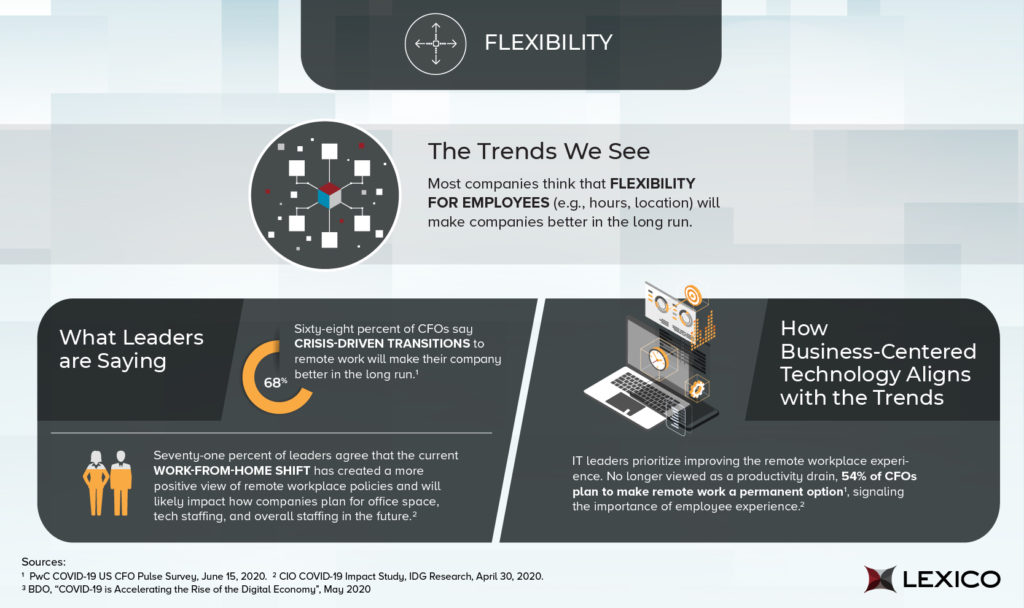Based on insights from business and technology leaders, we’ve created a new series on boosting digital transformation ROI through a business-centered technology approach. We’ve identified four key trends on this topic and are taking a deeper dive into each one, so you have a pulse on the ever-changing nature of digital transformation.
What is Flexibility Transformation?
Flexibility transformation refers to the process of making an organization more flexible in order to adapt to changing market conditions, customer needs, and technological advances. This can involve changes to the organization’s business model, processes, and culture. The goal of flexibility transformation is to create an organization that is more agile, responsive, and able to adapt to change quickly.
Benefits of Flexibility in Business
We’ve seen a seismic paradigm shift in how people work. This new “how”, caused by the crisis-driven emergence of the flexible remote workplace, has impacted productivity, culture, employee well-being, staffing strategy, and office space in unprecedented ways. So what do leaders think about this? How does this new flexibility in the workplace affect their ability to take a business-centered approach to their technology decisions in a digital transformation?
For businesses, harnessing the potential of digital transformation can deliver unparalleled benefits. Being seen as “digitally-savvy” is a competitive and commercial imperative in a world where those at the forefront of technological innovation routinely outpace stragglers in terms of revenue generation and profitability, according to IBM. This can help organizations to stand out from their competitors by demonstrating to the market that they are successfully navigating the challenges of digital transformation and reaping the rewards. The remote workplace is arguably one of the most visible demonstrations of that success.
Flexibility Technology Transformation Trends
Furthermore, the research we’ve uncovered demonstrates that C-suite leaders see the benefits of the more flexible remote workplace model. Here is a closer look into the trend of Flexibility that we’ve uncovered.
68% of CFOs say crisis driven transitions to remote work and that flexibility for employees (e.g., hours, location) will make companies better in the long run.
71% of leaders agree that the current work from home shift has created a more positive view of remote workplace policies and will likely impact how companies plan for office space, tech staffing and overall staffing in the future.
IT leaders prioritize improving the remorse workplace experience. No longer viewed as a productivity drain, 54% of CFO’s plan to make remote work a permanent option, signaling the importance of employee experience.
How Flexibility in Business Supports Business-Centered Technology
- It allows for quick adaptation to change: A flexible business model allows organizations to respond quickly to changing market conditions, customer needs, and technological advances, which is crucial when implementing new business-centered technology.
- It enables experimentation: Flexibility in business allows organizations to experiment with new technology and business models, which can help to identify opportunities for growth and innovation.
- It supports scalability: Flexibility in business allows organizations to scale up or down their operations as needed, which can be important when implementing business-centered technology that requires additional resources.
- It allows for diversification: A flexible business model allows organizations to diversify their revenue streams and explore new markets, which can provide a cushion against economic downturns and help to mitigate risk.
- It encourages innovation: Flexibility in business encourages innovation by providing the necessary space for experimentation and creativity, which is crucial for organizations that want to stay ahead of the curve with new business-centered technology.
- It allows for remote work: Flexibility in business allows for remote work which can support the implementation of business-centered technology that enables remote work and collaboration.

But the flexibility that comes with the remote workplace also has some risks. Beyond the changing shape of teams and organizational ways of working, technology is driving wider changes to employees in terms of how they work. This can cause uncertainty, sometimes resulting in an aversion to change.
That’s why we need to stick to the fundamentals of the “what” of business, in the midst of the changes and increased flexibility of “how” we do things. According to Lexico lead advisor Tom Winter, the “what” of business – cost management, revenue growth, customer service – remains constant. Navigating the new “how” requires embracing change and leading with clarity, conviction and taking a back-to-basics approach to be successful.
